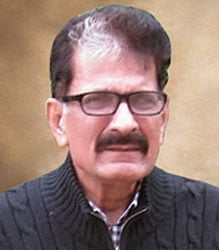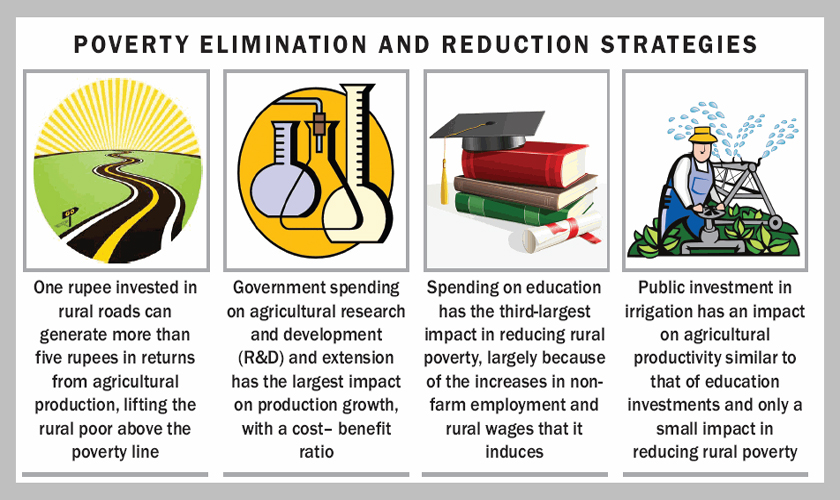POVERTY
The segment of society that enters and comes out of poverty periodically always lives in fear as unlike segments that are living in poverty for generations, they have tasted the comforts of life in good times.
 The small farmers are an example in this regard. They need a good crop coupled with good prices to live comfortably. One crop failure as happened in case of cotton this year pushes them back into poverty.
The small farmers are an example in this regard. They need a good crop coupled with good prices to live comfortably. One crop failure as happened in case of cotton this year pushes them back into poverty.
On the other hand, though the harvest of wheat and potato was excellent this year, the rates the farmers got did not cover their cost, and they also lost the comforts of life. The rural economy of Pakistan is based only on agriculture, so the rural population generally remains vulnerable to weather and market economy dominated by the middlemen.
Currently the rural population of the country is under pressure as commodity rates are still depressed globally. The import of subsidised agricultural products is also adding to the woes of the farmers.
A huge agricultural package may provide temporary relief to the farmers but the long time benefits are subject to upgrade of the agriculture infrastructure; development of new seed varieties; and elimination of middlemen by connecting farms with markets. Poor planning and bad governance has landed the nation in to the present mess.
The government’s poverty elimination and reduction strategies lack substance and a well thought out mitigation plan. Instead of conducting studies to determine the causes and develop any policies to reduce poverty, it simply announced a relief package. Offering money when farmers protested was merely a cosmetic solution.
Studies in neighbouring India indicate that investment on road infrastructure reduces poverty more sharply than other developments. India’s experience shows that for every one million rupees spent on rural roads, 124 poor people are lifted above the poverty line—the largest rate of poverty reduction among all types of investment.
Furthermore, one rupee invested in rural roads would generate more than five rupees in returns from agricultural production, which is the second-largest production growth effect after agricultural research and development (R&D). Additional government spending on agricultural R&D and extension has the largest impact on production growth, with a cost– benefit ratio of 13; it also leads to large rural poverty-reduction benefits, second only to rural road investment.
Additional government spending on education has the third-largest impact in reducing rural poverty, largely because of the increases in non-farm employment and rural wages that it induces. Finally, public investment in irrigation has an impact on agricultural productivity similar to that of education investments and only a small impact in reducing rural poverty.
The economists regret that no such analysis is available in Pakistan. Among the provincial governments, only Punjab has initiated a rural road programme lately which would take some time to show its impact.
Even in urban areas, not everyone who is poor was born into poverty. A large number of the urban population plunge into poverty and come out of it during the booms and busts in the economy. Reduction in poverty can be seen in urban areas in recent years due to increased industrial and construction activities. Those that slumped into poverty during 2008-13 periods are now seeing better times as employment opportunities increase. The poverty reduction strategy for urban poor should be different from the strategy adopted for the rural poor. Uninterrupted food supply chain could keep the food prices stable in urban regions. Except for fixed income groups or elite class, a majority of urban families in Pakistan buy food on daily basis.
There are families in poor localities that buy one or two kilogram of wheat flour daily instead of buying a 20 kilogram bag for a week or month. Any interruption in supplies makes them vulnerable. Rural poor generally grow their basic foods at home. The urban poor consume 60-70 percent of their income on food. Any food inflation badly hurts the poor, particularly those living in cities.
 Conventionally, poverty has been measured as a stock, considering the numbers of poor people at a particular moment in time. Such stocks can be compared across two points in time and the net change calculated. Such analysis does not reveal, however, exactly how this change was derived: how many people fell into poverty within the specified time frame, and how many others concurrently escaped poverty.
Conventionally, poverty has been measured as a stock, considering the numbers of poor people at a particular moment in time. Such stocks can be compared across two points in time and the net change calculated. Such analysis does not reveal, however, exactly how this change was derived: how many people fell into poverty within the specified time frame, and how many others concurrently escaped poverty.
Currently, poverty is on the rise in rural areas of the country, where 65 percent of our population resides. It is on decline in the urban regions because of accelerated economic activities. If rural poverty is not prudently addressed, it would accelerate migration to the urban centres. The urban regions already lack basic civic facilities. As a result, the cities would become unmanageable.
Poverty is pain. Poor people suffer physical pain that comes with too little food and long hours of work; emotional pain stemming from the daily humiliations of dependency and lack of power; and the moral pain from being forced to make choices such as whether to pay to save the life of an ill family member or to use the money to feed their children.
While quantitative measures provide important aggregate-level information, such data is able to tell only a partial story. Poverty varies across and within countries; its precise contours and dimensions are always contingent on time, place, and social groups involved. Aggregate data by definition does not reveal location specific variations. Neither does the data reveal the more subjective elements of poor people’s experience of poverty or the ways in which individuals cope. Amartya Sen has frequently argued that absolute poverty includes what Adam Smith called "the ability to go about without shame".
Poor people repeatedly stress the anxiety and fear they experience because they feel insecure and vulnerable. They describe security as stability and continuity of livelihood, predictability of relationships, feeling safe and belonging to a social group. Security is peace of mind and the possibility to sleep relaxed.
The multiple dimensions of deprivation demand multiple interventions. Policy makers should devise ways to empower poor that ensures for them adequate assets and livelihood. They will remain vulnerable if their material poverty is not addressed. There is a need to remove them from isolation by giving priority to infrastructure in slums the same way that is provided in posh localities.
The civic services should be ensured by providing them water, sanitation, gas facilities that are available in areas that are not poor. Efforts to provide pure drinking water by installing reverse osmosis plants should be accelerated.
Rich have adequate resources to look after their health. The poor face more health problems because they live in polluted environments without proper sewerage. The planners should ensure that existing state healthcare facilities are transparently available to them. In case the government lacks resources and capacities, it should handover at least the emergency services to non-government organisations on the pattern of children emergency at Jinnah Hospital Karachi where the private sector donors pour three times more funds to hire four times more doctors and nurses in children emergency; and provide free treatment to all.
All schools, public or private should teach the same curricula. Instead of forcing the private schools to follow government curricula the government should interact with major private school chains to design a national curriculum. This will ensure a level playing field to the poor children that cannot afford to go to private schools.
Unequal and troubled gender relations should be addressed as well to ensure equity and harmony. Women are vulnerable to abuse and violence in the home, when widowed, and in the workplace.
Men, particularly young men are more likely to be picked up by the police. Fear and lack of protection in the poor impacts their productivity. There is a need to convert it into peace and security. Poor are the main victims of petty corruption and are abused at all levels. Better governance, rule of law and accountability of the abuser is essential to eliminate this trend.
The writer is a staff member